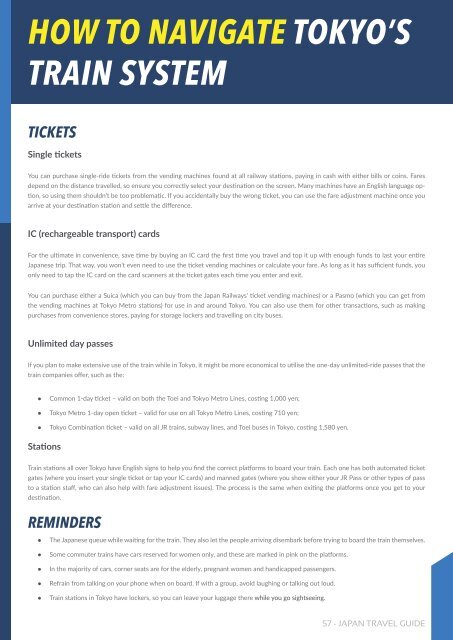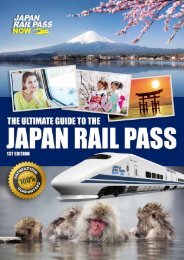Japan Rail Pass Now - Japan Travel Guide
Japan Travel Guide by Japan Rail Pass Now (www.japanrailpass.com.au)
Japan Travel Guide by Japan Rail Pass Now (www.japanrailpass.com.au)
Create successful ePaper yourself
Turn your PDF publications into a flip-book with our unique Google optimized e-Paper software.
How to Navigate Tokyo’s<br />
Train System<br />
Tickets<br />
Single tickets<br />
You can purchase single-ride tickets from the vending machines found at all railway stations, paying in cash with either bills or coins. Fares<br />
depend on the distance travelled, so ensure you correctly select your destination on the screen. Many machines have an English language option,<br />
so using them shouldn’t be too problematic. If you accidentally buy the wrong ticket, you can use the fare adjustment machine once you<br />
arrive at your destination station and settle the difference.<br />
IC (rechargeable transport) cards<br />
For the ultimate in convenience, save time by buying an IC card the first time you travel and top it up with enough funds to last your entire<br />
<strong>Japan</strong>ese trip. That way, you won’t even need to use the ticket vending machines or calculate your fare. As long as it has sufficient funds, you<br />
only need to tap the IC card on the card scanners at the ticket gates each time you enter and exit.<br />
You can purchase either a Suica (which you can buy from the <strong>Japan</strong> <strong>Rail</strong>ways’ ticket vending machines) or a Pasmo (which you can get from<br />
the vending machines at Tokyo Metro stations) for use in and around Tokyo. You can also use them for other transactions, such as making<br />
purchases from convenience stores, paying for storage lockers and travelling on city buses.<br />
Unlimited day passes<br />
If you plan to make extensive use of the train while in Tokyo, it might be more economical to utilise the one-day unlimited-ride passes that the<br />
train companies offer, such as the:<br />
●<br />
●<br />
●<br />
Common 1-day ticket – valid on both the Toei and Tokyo Metro Lines, costing 1,000 yen;<br />
Tokyo Metro 1-day open ticket – valid for use on all Tokyo Metro Lines, costing 710 yen;<br />
Tokyo Combination ticket – valid on all JR trains, subway lines, and Toei buses in Tokyo, costing 1,580 yen.<br />
Stations<br />
Train stations all over Tokyo have English signs to help you find the correct platforms to board your train. Each one has both automated ticket<br />
gates (where you insert your single ticket or tap your IC cards) and manned gates (where you show either your JR <strong>Pass</strong> or other types of pass<br />
to a station staff, who can also help with fare adjustment issues). The process is the same when exiting the platforms once you get to your<br />
destination.<br />
Reminders<br />
●<br />
●<br />
●<br />
●<br />
●<br />
The <strong>Japan</strong>ese queue while waiting for the train. They also let the people arriving disembark before trying to board the train themselves.<br />
Some commuter trains have cars reserved for women only, and these are marked in pink on the platforms.<br />
In the majority of cars, corner seats are for the elderly, pregnant women and handicapped passengers.<br />
Refrain from talking on your phone when on board. If with a group, avoid laughing or talking out loud.<br />
Train stations in Tokyo have lockers, so you can leave your luggage there while you go sightseeing.<br />
57 - <strong>Japan</strong> <strong>Travel</strong> <strong>Guide</strong>



